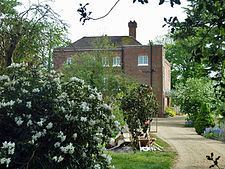Condition Inhabited Material Sandstone | Materials Sandstone | |
 | ||
Grid reference grid reference TQ425440 Similar Haxted Watermill, Lingfield railway station, Thorndon Country Park North, Coronation Chair, Edenbridge Town railway st | ||
Haxted flyers starborough castle warming 1996
Starborough Castle, known historically as Sterborough Castle, is a Neo-Gothic garden house of dressed sandstone near the eastern boundary of Surrey, built in 1754 by Sir James Burrow. It occupies the north-eastern portion of an artificial island south of the River Eden, roughly 3 km to the south-west of Edenbridge. It is a Grade II* listed building and scheduled monument, and was built on the site of the first castle, a medieval fortified house built c. 1341.
Contents
- Haxted flyers starborough castle warming 1996
- Map of Starborough Castle Moor Ln Marsh Green Dormansland Edenbridge TN8 5QY UK
- History
- References
Map of Starborough Castle, Moor Ln, Marsh Green, Dormansland, Edenbridge TN8 5QY, UK
History
The first Starborough Castle was the manor house of Reginald de Cobham, 1st Baron Cobham, and 1st Lord Cobham of Sterborough. On 18 October 1341 Cobham was granted licence by Edward III to crenelate the building, and the following year the building was fortified and became Starborough Castle. The castle was of a similar quadrangular style to Bodiam Castle, consisting of four towers and a gate, surrounded on all sides by a moat, with a central bridge crossing at the south.
After the Battle of Agincourt in 1415, the Duke of Orleans was for a time held captive in the castle. The castle passed to Edward Burgh through his c. 1476 marriage to Anne Cobham, daughter of Sir Thomas, de jure 5th Baron Cobham of Sterborough.
On 4 July 1648 the castle was ordered to be destroyed by Order of Parliament under the rule of Oliver Cromwell. It was feared the castle would provide a base for Royalist Rebellion forces. Only the moat survives, although parts of the original castle were used to build the present building on the north-east corner of the site.
In the 1700s the site became part of a country garden, before Sir James Burrow constructed the manor house now known as Starborough Castle in 1754. Although the site fell into ruin for a long period, Ray Edwards, a local farmer and builder, restored the site, before selling it to Warwick Leadlay. Under Leadlay outbuildings were added, with the site being used for an annual jazz festival. Leadlay placed the castle for sale in 2003.
